|
Report from
Europe
European plywood imports rebound 14% in 2024
Total EU+UK imports of plywood from outside the region
in 2024 were 3.77 million cu.m, up 14% compared to the
previous year when imports were at the lowest level for 15
years. Import value increased by 8% to US$1.82b last
year.
While the rebound was significant, import quantity in
2024 was still the second lowest in a decade and well
below annual average imports of 4.25 million cu.m in the
years immediately before the covid pandemic. The rise in
2024 owed much to a sharp increase in imports during the
last quarter of the year, particularly in temperate hardwood
plywood from China (Chart 1a).
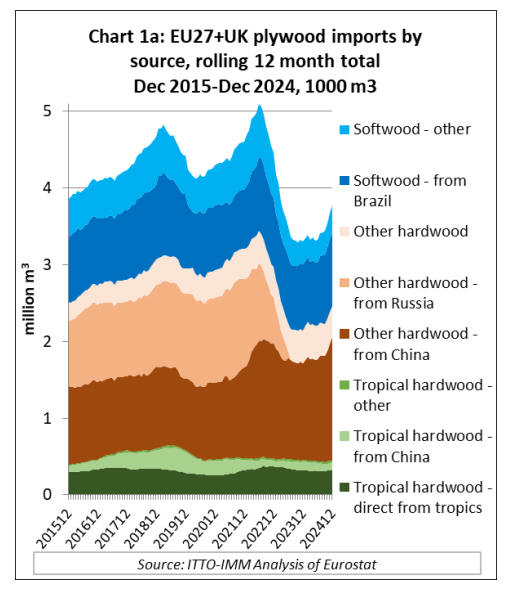
In terms of import market share in the EU+UK region, the
biggest shift last year was an increase in the share of
plywood faced with temperate hardwood from China,
largely at the expense of tropical hardwood plywood, both
direct from the tropics and from China (Chart 1b).
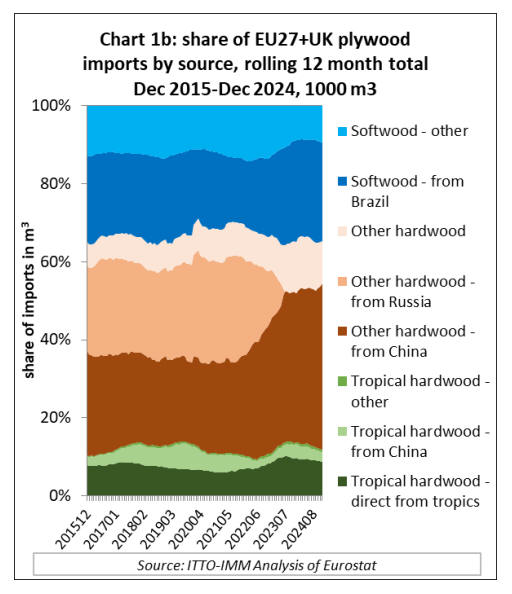
Sharp rise in European market share for Chinese
hardwood plywood
The share of temperate hardwood plywood from China in
total EU+UK import quantity increased from 38.1% in
2023 to 42.6% in 2024.
The import share of temperate hardwood plywood from
other countries fell from 13.2% in 2023 to 10.9% in 2024,
continuing a sharp declining trend which began in 2022
with the progressive tightening of European sanctions
against wood products originating in Russia and
Belorussia.
The share of tropical hardwood plywood in total EU+UK
imports fell from 13.7% in 2023 to 11.8% in 2024, with
the share of direct imports from the tropics down from
9.6% to 8.8% and import share from China down from
3.6% to 2.4%. The share of softwood plywood in total
EU+UK imports fell slightly from 34.9% to 34.6% with
Brazil maintaining its dominance of this market.
EU domestic plywood manufacturers have been unable to
significantly increase production in response to the supply
gap that opened following the sanctions on Russian and
Belorussian products.
Data from the European Panels Federation (EPF) indicates
that total EU plywood production fell 15% to 2.6 million
cu.m in 2023, the lowest ever recorded and only about half
the volume of nearly 5 million cu.m per annum prevailing
before the COVID pandemic.
EU plywood production figures for 2024 are not yet
available, but EPF projected last year that it was unlikely
to increase by more than 2%.
Weak construction sector leads to low plywood
consumption in Europe
On the import side, European importers were reporting no
significant problems in obtaining sufficient volume to
meet demand in 2024. Rather the historically low level of
imports during the year was driven by continuing slow
consumption. The Eurostat construction production index
fell by 1.3% between January and September last year,
although it did recover all the lost ground in the last
quarter.
Another factor impeding plywood imports last year was a
sharp hike in freight rates from Asia to Europe during the
middle of the year. This was partly attributed to attacks on
shipping in the Red Sea, leading to vessels having to avoid
the Suez Canal and take the long route around the tip of
Africa.
On the Shanghai to Rotterdam route, rates for 40-ft
contained increased from around $3000 at the start of May
to peak at over $8250 at the end of July, before falling
back to around US$4000 by the end of October. This year
they have fallen further and now stand at around
US$2300.
European imports of tropical hardwood plywood down
2% in 2024
Imports of plywood faced with tropical hardwood into the
EU+UK region last year totaled 446,900 cu.m in 2024, 2%
less than the previous year. In value terms imports
increased 3% to US$293m last year. Last year EU+UK
imports of tropical hardwood plywood direct from tropical
countries held up better than imports of tropical hardwood
plywood from China (Chart 2).
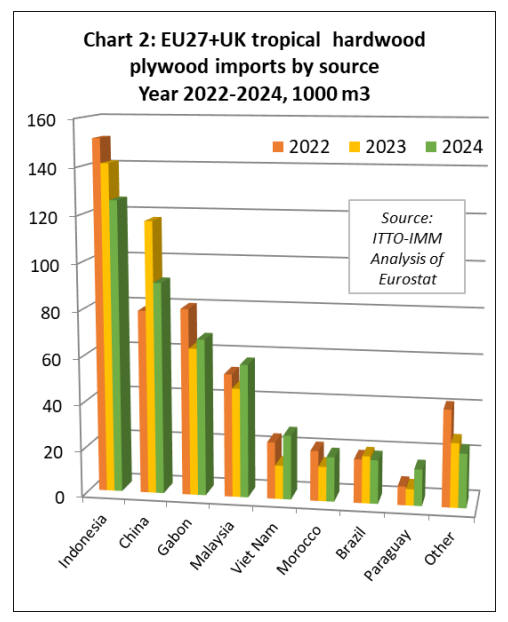
EU+UK imports of tropical hardwood faced plywood from
China, mainly destined for the UK, decreased 22% to
91,300 cu.m in 2024. However, EU+UK plywood imports
direct from tropical countries in 2024 were 330,400 cu.m,
4% more than the previous year.
There was a 6% increase in imports from Gabon to 67,600
cu.m, a strong 22% rebound in imports from Malaysia to
57,500 cu.m, and a 91% increase in imports from Vietnam
to 27,700 cu.m. Imports of okoume plywood from
Morocco were also up 29% to 19,300 cu.m, and
eucalyptus plywood imports from Paraguay increased by
122% to 15,700 cu.m.
These gains were partly offset by an 11% fall in tropical
hardwood plywood imports from Indonesia to 125,700
cu.m and a 7% decline from Brazil to 18,800 cu.m.
European imports of temperate hardwood plywood
increase 19% in 2024
EU+UK plywood imports of temperate hardwood
plywood increased 19% to 2,019,600 cu.m in 2024.
Imports of temperate hardwood plywood increased 10% in
value terms, to US$1.03b.
The gains were mainly due to imports from China and
Ukraine, which were 1,609,000 cu.m and 206,400 cu.m in
2024, respectively 28% and 39% more than in the
previous year. Imports of temperate hardwood plywood
from Kazakhstan were down 49% to 73,000 cu.m last
year, while those from Turkey fell 53% to 27,800 cu.m.
However, imports from Georgia increased 172% to 26,800
cu.m (Chart 3).
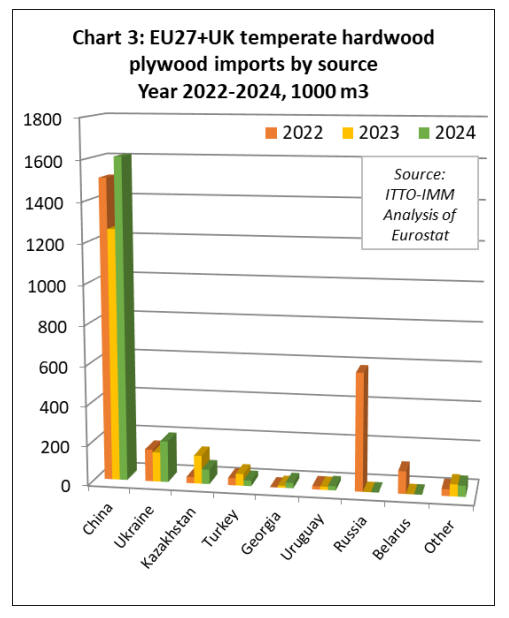
Rising European imports of softwood plywood from all
leading supply countries
The EU+UK region imported 1,306,900 cu.m of softwood
plywood in 2024, 13% more than the previous year.
Import value increased 9% to US$494m during the year.
Import quantity increased from all the main supply
countries including Brazil (+11% to 935,500 cu.m), Chile
(+20% to 174,900 cu.m), China (+47% to 95,200 cu.m),
South Africa (+33% to 20,800 cu.m), and Uruguay (+88%
to 20,600 cu.m).
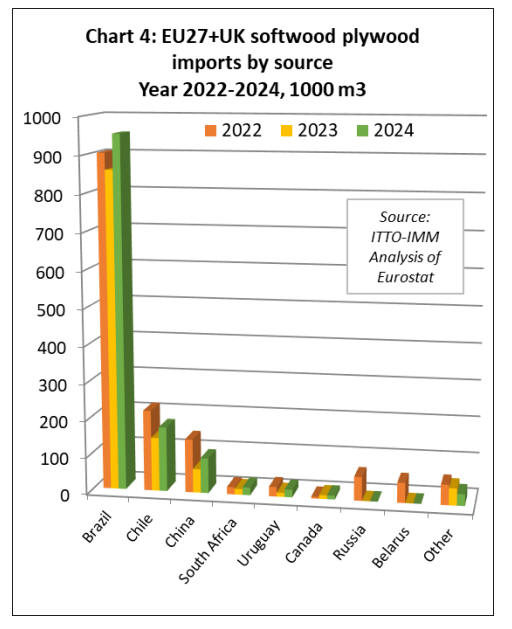
EU anti-dumping measures targeting plywood imports
The decline in European imports of temperate hardwood
plywood from Kazakhstan and Turkey in 2024 followed
on from the extension of EU anti-dumping measures on
imports of birch plywood, previously applied to Russian
products, to imports from the two countries.
The European Commission announced the extension in
May last year following their investigation which
concluded that EU anti-dumping duties on imports of
birch plywood from Russia were being circumvented by
imports transshipped from Russia to Kazakhstan and
Turkey, or sent for final completion to these countries,
preceding shipment of the finished product to the EU.
In October 2024, the European Commission initiated an
additional anti-dumping investigation, this time
concerning imports of hardwood plywood from China.
That investigation is still on-going. As part of this
procedure, in December 2024 the EU introduced a law
requiring registration of all hardwood plywood imports
from China.
The measure is designed to ensure that all such imports
entering the EU are meticulously recorded by national
customs authorities. According to the law, the purpose of
registration is “to ensure that, if the investigation results in
findings leading to the imposition of anti-dumping duties,
those duties can, if the necessary conditions are fulfilled,
be levied retroactively on the registered imports”.
In March this year, the European Commission launched an
anti-dumping investigation into allegations by a
consortium of large European plywood producers that
Brazilian softwood plywood imports in the EU are being
sold at unfairly low prices.
As part of the probe, all Brazilian softwood plywood
imports must now be registered at EU borders to allow
customs authorities to retroactively impose additional
duties if the investigation confirms dumping practices.
US-EUface-off on tariffs
Following the US administration’s announcement to
impose US tariffs of 25% on all aluminium and steel
imports the EU launched a consultation in March on
possible retaliatory tariffs. A very large range of US forest
products were included in the initial list of products
pencilled in for retaliatory EU tariffs. Several EU forest
products trade and industry groups provided input into the
EU consultation asking that these products be removed
from the list to discourage any imminent trade war
between the US and EU from spilling over into the forest
products sector.
On 2 April, the US President issued an Executive Order
that imposed, starting 9 April, an additional ad valorem
duty on all US imports from all trading partners, with
some specific exceptions.
For the forest products sector, a notable exception is
everything up to and including 4413 in HS Chapter 44 -
that is biomass, chips, poles, logs, lumber, sleepers,
mouldings, veneer, plywood and densified wood.
These wood products are exempt from the 2 April
Executive Order because they are subject to an on-going
investigation under the terms of another Presidential
Executive Order issued on 1 March targeting lumber
products that may lead to alternative sector-specific tariffs
in the future.
The additional US duty on products not subject to an
exception was slated to start at 10% for all trade partners
with additional duties above this level imposed on trading
partners determined largely by the size of their trade
surplus in goods with the U.S. The duty on goods imports
from the EU was slated at 20%, while the UK would be
subject to the baseline 10% tariff.
The EU voted on 9 April on the first tranche of US
products to be subject to 25% retaliatory tariffs in response
to the earlier U.S. tariffs on steel and aluminium products.
While some U.S. hardwood products have been targeted
by the EU, the list is much reduced from the original
proposal sent out for consultation in March.
According to unofficial analysis by the American
Hardwood Export Council, products targeted for EU
retaliatory tariffs account for around 10% of the total value
of US hardwood primary products imports (logs, lumber,
veneer, plywood, mouldings) into the EU.
The EU retaliatory list excluded some of the largest U.S.
hardwood export items, notably all hardwood logs, all oak
lumber, lumber of “other” hardwood species (which
covers species such as walnut, tulipwood, and hickory),
and thin veneers. The products included were generally
less prominent in U.S. exports to the EU, such as ash,
cherry, and maple lumber.
Following the 9 April announcement of a 90-day delay to
the imposition of all US tariffs above the 10% baseline to
allow time for negotiations, the EU responded by
announcing that their package of retaliatory tariffs would
also be delayed. The EU tariffs on US hardwood products
are now scheduled to be imposed from 16 July.
Overall, the fact that both the US and EU have so far
refrained from imposing additional tariffs on their bilateral
trade in primary wood products has been seen by the wood
industry in the EU as a partial win in their efforts to avoid
the forest products sector being dragged into the wider
trade war.
It is only a partial win because a large proportion of
secondary and tertiary processed wood products, including
all wood furniture products, are still slated for retaliatory
tariffs by both the US and EU, respectively of 20% and
25%, in their bilateral trade. If no agreement can be
reached in on-going negotiations these tariffs will be
imposed in July.
Challenge to EU manufacturers from products diverted
away from the US
For the European forests products sector the direct impact
of additional tariffs on bilateral trade with the US, while
significant, may be less of an issue than the impact of the
new US tariffs on global supply chains and the wider
economy.
Total EU exports of forest products to the US, which
averaged US$9.37 bil. each year between 2022 and 2024,
accounted for 14% of the US$65 bil. total EU annual
exports of forest products outside the region during that
period.
A large proportion of EU products exports to the US
include added-value products such as wood furniture,
finished joinery, engineered wood and specialist paper
products that will be subject to the US 20% import tax if
no agreement is reached between the US and EU before
July. This would be a significant hit to overall EU forest
products exports but not an overwhelming challenge for
most manufacturers which are oriented more towards
supplying the large domestic market.
A bigger challenge may arise from the diversion of a large
proportion of products produced in other parts of the
world, previously destined for the US, towards the
European market. Last year, the US imported US$66 bil.
of forest products including US$22 bil. of wood (HS44),
US$22 bil. of wood furniture (HS94), US$18 bil. of paper
(HS48) and US$4 bil. of pulp (HS47).
Switching even a relatively small proportion of this
volume towards European markets could quickly
overwhelm domestic manufacturers already struggling
under pressure of relatively low consumption and high
costs of production.
This risk of diversion to Europe is heightened by US
plans, announced on 18 April, to impose port fees on
Chinese ships arriving at US ports. From mid-October,
Chinese ship-owners and operators will be charged US$50
per tonne of cargo with the fees increasing by US$30 a
tonne each year for the next three years.
This may increase the likelihood of the EU launching
further anti-subsidy and anti-dumping investigations and
implementing other policy measures to protect domestic
manufacturers in the forest products and other sectors in
the future.
On the other hand, as noted in a recent article on the
Politico website, “now that the United States…is
convulsing global markets and trade networks with its
barrage of duties - the European Union is being quick to
step up and cast itself as the heavyweight liberal trade bloc
that is open for business”. Swedish Trade Minister
Benjamin Dousa told Politico on the margins of a recent
meeting of EU trade ministers in Luxembourg that “there
is a sense of urgency among member states that we have to
open new trade routes, we have to sign new free trade
agreements.”
According to Politico, “Since being confirmed in
December, von der Leyen’s European Commission II,
which handles trade policy on behalf of the bloc’s 27
members, has been on a deal-making roll. Brussels has
concluded decades-long talks with the Mercosur bloc, as
well as with Mexico and Switzerland. It has also
relaunched negotiations with Malaysia and opened
discussions with the United Arab Emirates. Von der Leyen
has pledged to wrap up a hard-to-get FTA with India this
year and is eager to explore ‘closer cooperation’ with the
Comprehensive and Progressive Agreement for Trans-
Pacific Partnership (CPTPP)”.
These agreements are for the future, but for now some
early signs of trade diversion away from the US to the
European market are already emerging. An article by the
British Broadcasting Corporation (BBC) quotes Marco
Forgione, Director General of the Chartered Institute of
Export & International Trade, as suggesting that the tariffs
have already caused "significant build ups" of ships,
especially in the European Union, but also "significant
congestion" at UK ports.
"We've seen a lot of diversion of ships from China that
were due to head to the US, diverting and coming to the
UK and into the EU," Mr. Forgione is reported to have
said. In support of this, the BBC notes that in the first
three months of 2025 Chinese imports into the UK have
increased by about 15% and into the EU by about 12%.
The BBC article also refers to comments by Sea-
Intelligence, an independent analyst, that there may be an
“all-time high deployment of ocean shipping capacity on
the Asia to North Europe route
Other analysts note that tariffs are only one factor
contributing to current congestion at European ports. The
BBC quotes Sanne Manders, president of logistics firm
Flexport, as saying that strikes at ports in the Netherlands,
Germany and Belgium in the first three months of the year
are also playing a role. He also observed that while
shippers are looking for new markets, there may be well
be a surge of goods to the US to try to take advantage of
the 90-day window for goods from some countries.
Impact of tariffs on European economy may be small
The potential impact of the tariffs on the wider European
economy has been analysed by Bruegel, an independent
European thinktank. Bruegel note that the hit for the
European economy will depend on the actual tariff rate the
US settles on and on the EU’s response, both of which are
still uncertain. However, Bruegel also suggests that the
overall shock is small compared to other recent shocks
such as the covid pandemic and the energy crises that
followed Russia’s invasion of Ukraine.
Bruegel summarises the findings from five studies that
estimate the long-term impacts on Europe of various tariff
scenarios – including a trade deal with the US, unilateral
US tariffs and US tariffs plus retaliation. The average
assessed impact across all studies and scenarios is a 0.3%
contraction in EU-wide GDP. All scenarios bar one
calculated a drop between zero and 0.5 percent of GDP for
the EU.
The overall shock is constrained because of the relatively
limited exposure of the EU economy to trade with the US.
While 21% of total extra-EU exports go to the US, the EU
value added embedded in them represented only about
2.9% of EU GDP in 2021. However, some EU countries
are more exposed than others. The German economy could
be particularly severely affected if no agreement with the
US is reached, with an average estimated GDP contraction
of 0.4%.
See: https://www.bbc.co.uk/news/articles/cly517p1zgqo
and
https://www.bruegel.org/analysis/economic-impact-trumps-
tariffs-europe-initial-assessment
and
https://www.politico.eu/article/us-donald-trump-tariff-war-
empowering-eu-europe-free-trade-commission/
|